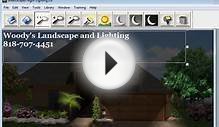
The Approach of Landscape Lighting Design
You start with a dark palette then do two things:
1. Selectively illuminate objects of interest and beauty, and
2. Create new shapes and patterns through the interplay of light and shadow.
This approach enables you to create lighting effects that accomplish the goals of the lighting design. What are these goals? Read on.
The Goals of Landscape Lighting Design.
- Safety. Illumination that ensures safe navigation throughout the property.
- Security. Illumination that deters, detects, identifies, and enables apprehension of intruders.
- Beauty. Illumination that evokes positive aesthetic and emotional responses.
- Functionality. Illumination that provides appropriate lighting for activities performed on the property.
- Economy. Illumination that conserves financial and energy resources.
- Environment. Illumination that minimizes light pollution and light trespass.
Satisfying all these goals may seem overwhelming, but there's is nothing wrong with taking a simple approach and to focus on one or two at a time. For example, you may decide to light the pathway leading to your front door. Your main goal is probably 'safety' since you want the illumination to reveal the edges of the path and any irregularities that could cause tripping. Secondarily, you want 'beauty'.
In this case, to satisfy safety and beauty is straightforward - just select path lights that have a good wide coverage, and that are (themselves) beautiful. In fact, without knowing it, you may be satisfying all or most of the other goals without even trying. This is especially the case when you select premium-quality landscape lights such as those from VOLT® Lighting.
If you are a determined do-it-yourselfer and wish to attempt a more in-depth approach to the design, don't try to light your entire property at one time. Instead, separate your property into regions or zones. Typical zones might be an entrance path, island garden bed, or backyard patio. Focus on just one zone and aim to illuminate it with all the goals in mind. Don't start the second zone till you finish the first. You'll find that your lighting design skill will improve with each zone you design and install.
You may also consider hiring an experienced lighting designer. These professionals spend many years mastering various techniques to produce beautiful and effective designs. Even though you love doing everything yourself, if you have the resources, hiring the pro is the surest way to end up with a great lighting design.
YOU MIGHT ALSO LIKE












